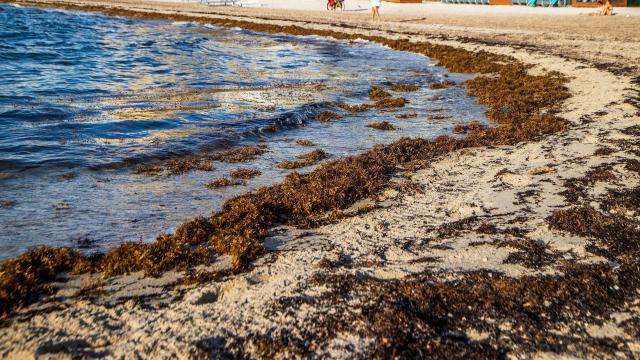A floating blob of seaweed 8,047 km across, spanning nearly the whole width of the Atlantic Ocean, is headed for Florida’s Atlantic Coast. The sargassum algae, a brown, branching, stringy seaweed that can turn seawater mud-coloured when present in large quantities, is likely to cause serious problems for the Sunshine State as well as the Caribbean and parts of Mexico, per multiple reports.
In past sizable seaweed blooms, sargassum has clogged up beaches with hundreds of tons of sticky, matted algae. To make matters even less appealing: The seaweed emits hydrogen sulfide gas as it decomposes, producing a rotten-egg like odor and causing potential respiratory irritation as well as digestive and neurological problems for people nearby.
The thick flotillas of organic matter can also end up clogging power plant intakes, desalination water plants, and boat traffic.
Then there are the ecological impacts of massive sargassum blooms. The algae provides some of the only wildlife habitat in the open ocean of the Sargasso Sea, where the rafts of seaweed grow and float most of the time. However, in recent damaging mega-bloom events, the algae is a less welcome intrusion — particularly in near-shore ecosystems. Sargassum blooms can choke up shallow coastal waters, block out light, degrade water quality, clog coral reefs, deplete oxygen, kill sea life, and more.
This year’s bloom is starting months earlier than usual and seems likely to be as bad as — if not worse than — any prior sargassum event on record. “It’s incredible,” Brian LaPointe, an ecologist at Florida Atlantic University, told NBC News. “What we’re seeing in the satellite imagery does not bode well for a clean beach year.” Researchers use satellite data to keep tabs on the algae.
Along Mexico’s Caribbean Sea coast, excessive amounts of the algae have started to appear on some beaches. Resorts have readied their plans to remove the seaweed from tourist spots and attempt to salvage their income. In brief: hundreds of people will work 24/7 to shovel and cart away the algae as it washes up. Cancun officials have said the marine material will be turned into biofertilizer, according to the Cancun Sun.
In Florida, beaches in Key West have also already begun to incur algal inundation, LaPointe told NBC News. There too, resorts and other private beach owners work to mechanically remove the seaweed from the sand. Florida’s Gulf Coast is already enduring one type of algal bloom, as an ongoing “red tide” event kills tons of fish and other sealife. With the incoming seaweed apocalypse, the peninsula would be surrounded on both sides by the consequences of a human-mucked up oceanic ecosystem.
Sargassum has long been a part of the Atlantic’s marine boom-and-bust system, but occurrences of the seaweed and its seasonal cycles seem to be shifting — to the detriment of humans and the environment.
The seaweed has bloomed en masse multiple times in recent years, with particularly large-scale occurrences recorded repeatedly since 2011. These events almost always happen in the summertime. But this year’s bloom started months earlier than normal, and scientists have indicated this current eruption of algae could eventually break the record for the largest sargassum bloom ever recorded.
Already, the amount of the seaweed present in the Atlantic has broken at least one monthly record. Back in February, sargassum scientist Chuanmin Hu of the University of South Florida told First Coast News that the algae’s growth in January 2023 “set a record for all previous January months.”
Though it’s not certain what’s responsible for this year’s early and significant sargassum bloom, both nutrient pollution and climate change are thought to contribute to the increasing severity of the seaweed’s seasonal proliferation. Things like agricultural runoff, sewage, storm events, upwellings, Saharan dust storms, and deforestation may force a flood of nutrients into the ocean that fuels rapid algal growth. Warmer waters, shifts in marine overturn, and increasing rainstorms causing runoff from the Amazon basin — all influenced by climate change — are also thought to be factors.
